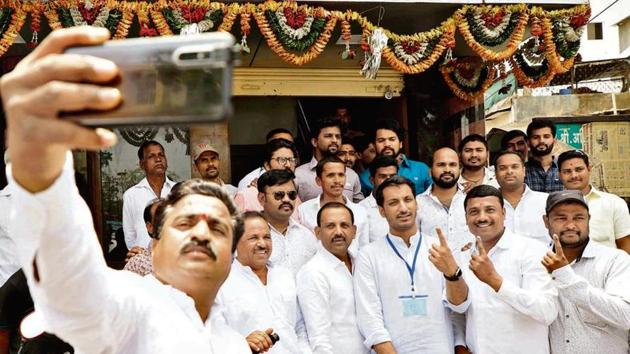Lok Sabha elections 2019: At phase value, looks like good news for the saffron combine in Maharashtra
After voting for the fourth and last phase in the state was held for 17 constituencies on Monday, the overall state turnout was recorded at 60.68 % (provisional), up from the 60.32% in 2014. The turnout recorded in the fourth phase is 57% (provisional), against 55.59% in 2014.
The larger turnout in urban areas in the fourth phase, including Mumbai, compared to 2014 and 2009, could mean good news for the BJP-Shiv Sena alliance. In Mumbai, the voting percentage improved to 55.11% this election, from 51.49% in 2014, while it has gone down in most rural constituencies.

After voting for the fourth and last phase in the state was held for 17 constituencies on Monday, the overall state turnout was recorded at 60.68 % (provisional), up from the 60.32% in 2014. The turnout recorded in the fourth phase is 57% (provisional), against 55.59% in 2014.
At its face value, according to political observers, the ruling combine succeeded in bringing out its voters, while the Congress-NCP apparently failed to mobilise it cadre at the booth level.
In parts of Mumbai, BJP’s loyal voters in plush areas like Mahavir Nagar in Kandivli, Mulund and Ghatkopar voters were seen standing in queues for hours.
“This clearly shows that the ruling parties succeeded in ensuring their voters come out in large numbers and vote for their candidate. I would not be surprised to see BJP-Sena combine sweeping all six seats or at least five of them,” said Pratap Asbe, political analyst.
According to primary estimates, slums and areas dominated by Muslim voters were comparatively less enthusiastic, as against the turnout in 2014. This may affect the prospects of Congress and NCP candidates. Congress could not even appoint polling agents in some areas, such as North Mumbai.
Former Mumbai Congress chief Sanjay Nirupam said Dalits, Muslims and North Indians have voted for Congress and NCP candidates. “Voters from slums have come out in big numbers. If the plush areas have voted in big numbers, it could be in favour of our candidates too. After Reliance chief Mukesh Ambani appealed to vote for Milind Deora, I think the Gujarati and business community has voted for us. ,” he said.
Congress also expects a chunk of dedicated BJP voters shifting loyalties to them owing to Raj Thackeray’s verbal attacks on Narendra Modi. “Marathi-speaking voters were confused to a large extent and it may benefit us,” a Congress leader said.
Like Mumbai, the voting percentage in tribal constituencies, such as Nandurbar and Dindori has witnessed a rise in percentage of the voting. This could be out of the anger the tribal community had against the BJP-led government over their decisions related to reservation. In other constituencies in rural and semi-urban areas, including Shirur, Shirdi and Maval, the Congress-NCP combine may have an edge over the ruling parties.
Although uproar was not as high as in 2014 over names missing from electoral rolls, some constituencies witnessed large complaints for deletion of names. Voters from Bhendi Bazaar and Mahul complained of missing names in big numbers.
In Nashik, NCP candidate Sameer Bhujbal’s mother was missing from the list. “Mahul could be a one-off case as residents were shifted from Vidyavihar as part of their rehabilitation plan. In other cases, we will investigate, but voters are given adequate opportunities to verify their names. The names are deleted only after following a due process,” said Ashwani Kumar, chief electoral officer, Maharashtra. Dilip Shinde, additional CEO, said 1,165 EVMs and 2,467 VVPATs were replaced after they developed technical snags.
Shinde also said the ban on mobile phones was as per instruction from the EC after it was found the gadgets were being misused in earlier phases. At many polling booths in Palghar, voting went on till as late as 9.15pm as there were long queues at the 6pm deadline. The EC expects updated voter turnout for the fourth phase to improve by 2% .






